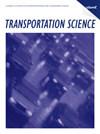多区域MFD城市网络模型预测周界控制的线性参数变化公式
IF 4.8
2区 工程技术
Q1 OPERATIONS RESEARCH & MANAGEMENT SCIENCE
引用次数: 2
摘要
最近引起人们关注的城市实时全网交通控制的另一种方法是周界流量控制。许多研究表明,这种方法比目前最先进的自适应信号控制策略更有效,用于异构拥挤的城市网络。这种方法的基本概念是将异质城市划分为少数同质区域(区),并对沿区域边界的区域间流动进行周界控制。在区域边界的交通交叉口控制换乘流,使拥堵分布最优,使系统总延迟最小。当前工作的重点是将原始非线性问题以线性变参(LPV)形式进行数学表述,以便将最优控制应用于(滚动水平)模型预测概念。这项工作提出了最优控制问题的数学分析,以及为了导出线性优化问题的公式而假设的近似和简化。为了验证该方法的有效性,给出了宏观环境(工厂)的数值模拟结果。对于作为“基准”的非线性情况以及线性情况,给出了闭环模型预测控制方案的结果。此外,将开发的方案应用于一个拥有500多个信号交叉口的欧洲城市的大规模微观模拟,以更好地研究其对现实条件的适用性。仿真实验表明,与固定时间控制相比,该方案的各项性能指标都得到了显著提高。资助:本研究由欧盟地平线2020研究与创新计划中的Dit4Tram“交通与移动管理分布式智能与技术”项目(授权协议953783)支持。本文章由计算机程序翻译,如有差异,请以英文原文为准。
A Linear-Parameter-Varying Formulation for Model Predictive Perimeter Control in Multi-Region MFD Urban Networks
An alternative approach for real-time network-wide traffic control in cities that has recently gained attention is perimeter flow control. Many studies have shown that this method is more efficient than state-of-the-art adaptive signal control strategies for heterogeneously congested urban networks. The basic concept of such an approach is to partition heterogeneous cities into a small number of homogeneous regions (zones) and apply perimeter control to the interregional flows along the boundaries between regions. The transferring flows are controlled at the traffic intersections located at the borders between regions so as to distribute the congestion in an optimal way and minimize the total delay of the system. The focus of current work is the mathematical formulation of the original nonlinear problem in a linear parameter-varying (LPV) form so that optimal control can be applied in a (rolling horizon) model predictive concept. This work presents the mathematical analysis of the optimal control problem as well as the approximations and simplifications that are assumed in order to derive the formulation of a linear optimization problem. Numerical simulation results for the case of a macroscopic environment (plant) are presented in order to demonstrate the efficiency of the proposed approach. Results for the closed-loop model predictive control scheme are presented for the nonlinear case, which is used as “benchmark,” as well as the linear case. Furthermore, the developed scheme is applied to a large-scale microsimulation of a European city with more than 500 signalized intersections in order to better investigate its applicability to real-life conditions. The simulation experiments demonstrate the effectiveness of the scheme compared with fixed-time control because all of the performance indicators are significantly improved. Funding: This work was supported by Dit4Tram “Distributed Intelligence & Technology for Traffic & Mobility Management” project from the European Union’s Horizon 2020 research and innovation programme under [Grant agreement 953783].
求助全文
通过发布文献求助,成功后即可免费获取论文全文。
去求助
来源期刊

Transportation Science
工程技术-运筹学与管理科学
CiteScore
8.30
自引率
10.90%
发文量
111
审稿时长
12 months
期刊介绍:
Transportation Science, published quarterly by INFORMS, is the flagship journal of the Transportation Science and Logistics Society of INFORMS. As the foremost scientific journal in the cross-disciplinary operational research field of transportation analysis, Transportation Science publishes high-quality original contributions and surveys on phenomena associated with all modes of transportation, present and prospective, including mainly all levels of planning, design, economic, operational, and social aspects. Transportation Science focuses primarily on fundamental theories, coupled with observational and experimental studies of transportation and logistics phenomena and processes, mathematical models, advanced methodologies and novel applications in transportation and logistics systems analysis, planning and design. The journal covers a broad range of topics that include vehicular and human traffic flow theories, models and their application to traffic operations and management, strategic, tactical, and operational planning of transportation and logistics systems; performance analysis methods and system design and optimization; theories and analysis methods for network and spatial activity interaction, equilibrium and dynamics; economics of transportation system supply and evaluation; methodologies for analysis of transportation user behavior and the demand for transportation and logistics services.
Transportation Science is international in scope, with editors from nations around the globe. The editorial board reflects the diverse interdisciplinary interests of the transportation science and logistics community, with members that hold primary affiliations in engineering (civil, industrial, and aeronautical), physics, economics, applied mathematics, and business.
 求助内容:
求助内容: 应助结果提醒方式:
应助结果提醒方式:


